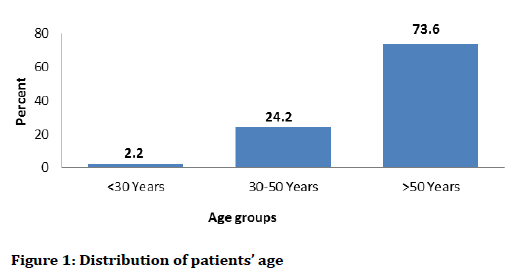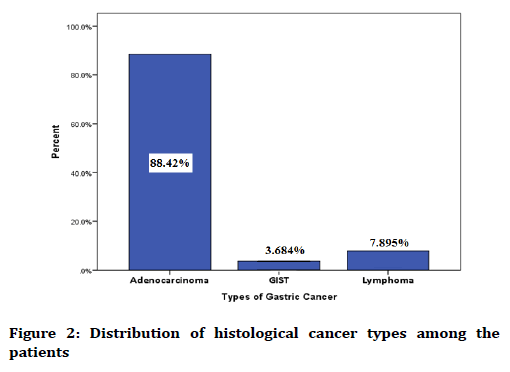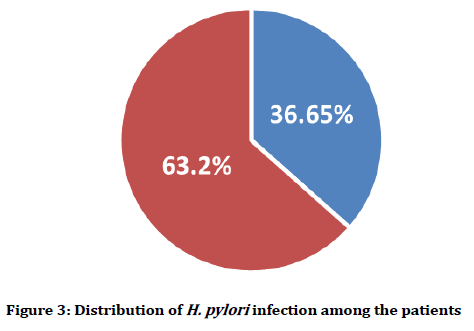Prospective - (2019) Volume 7, Issue 2
Distribution of Helicobacter pylori Infection among Gastric Cancer in Hiwa Hospital, Sulaimani City
Fadhil Ahmed Mohialdeen1*, Mohammed IM Gubari2, Khalid Anwar Hama-ghareeb3, Ahmad Rasul Ahmad1, Chrakhan Jalal Abdulrahim1, Nuha Ahmad Mhmad1, Amir Ali Sharif1, Renwarr Raouf Hama-Tahir1 and Bashdar Khdir Ali1
*Correspondence: Fadhil Ahmed Mohialdeen, Department of Community Health, Health Technical College, Sulaimani Polytechnic University, Sulaimani, Iraq, Email:
Abstract
Background: The association between gastric cancer and H. pylori infection has been supported in very few studies. In this regard, the present study was carried out in order to examine how of H. pylori infection is distributed among gastric patients.
Methods: The present study was a single cohort in which 190 patients who were clinically diagnosed with gastric cancer were recruited. The patientsâ records were utilized in order to collect data on H. pylori infection. The collected data were analyzed through descriptive statistics using SPSS software version 21.
Results: The results indicated that history of H. pylori infection was observed in 63.2% of the patients with gastric cancer. Moreover, prevalence of gastric cancer was more among females (61.5%), residents of rural areas (57.9%), and patients aged over 50 years (73.6%).
Conclusion: H. pylori infection was found to be more prevalent among patients with gastric cancer. Future studies are recommended to focus on larger samples in order to generalize the results in the Kurdistan Region.
Keywords
Gastric cancer, Helicobacter pylori, Infection
Introduction
It has been reported that gastric cancer (GC), which is one of the most prevalent tumors, afflicts one million new cases every year throughout the world [1]. Given the fact that gastric cancer is diagnosed in advanced stages in most cases and with poor prognosis and restricted therapy options, it is clinically regarded as a major challenging disease all over the world. GC develops in a multi-factorial and complex process, involving some etiological factors and several epigenetic and genetic alterations [2].
Helicobacter pylori infection is referred to as the strongest risk factor that is recognized for gastric adenocarcinoma. Although colonies of this bacterial species can be found in the stomach of over half of the world’s population, adenocarcinoma afflicts only a very small percentage of subjects. H. pylori can lead to chronic gastritis which might last for decades. Moreover, for the most frequent histological type of gastric adenocarcinoma, a multistep precancerous process has been recognized [3].
Limited data exist on H. pylori infection prevalence among patients with gastric cancer in the Kurdistan Region of Iraq. According to the available non-official reports revealed that H. pylori infection is highly prevalent among gastric cancer patients. In this regard, the present study was aimed at figuring out the prevalence of H. pylori infection among gastric cancer patients who had referred to Hiwa Hospital in Sulaimani province, the Kurdistan Region of Iraq.
Materials and Methods
The present investigation was a prospective study which was carried out through a single cohort that consisted of 190 patients who had referred to Hiwa Hospital during a period of 6 months during 2018. Before conduction of the data collection, each of the patients filled out a consent form.
Required medical data were collected from the patients via a structured questionnaire which was composed of two parts. The first part aimed to gather the patients’ socio-geographical information including their age, gender, place of living, and job.
The second part was used to collect the patients' medical data including cancer types, cancer stage, hematological and histological data, and serological result on H. pylori infection.
The collected data were encoded and fed into SPSS version 22, and descriptive statistics including frequency, percentage, mean and standard deviation was utilized.
Results
Demographic characteristics of patients
A total number of 190 patients participated in the present study (n=190), of whom 117 (61.5%) were females and 73 (38.4%) males. The participants' mean age was 61.4 years old (with a range from 28 years to 92 years of age).
Regarding the patients’ place of living, the results indicated that 110 (57.9%) resided rural areas and 80 (42.1%) urban regions. Most of the patients (29.5%) were housewives, followed by unemployed at 27.4%, workers with 23.2%, and governmental staff with 6.8%, police officers with 6.3%, teachers with 4.7%, and students with 2.1% (Table 1).
| The patients’ characteristics | No. | % | |
|---|---|---|---|
| Gender | Male | 73 | 38.4 |
| Female | 117 | 61.5 | |
| Residency | Urban | 80 | 42.1 |
| Rural | 110 | 57.9 | |
| Occupation | Housewife | 56 | 29.5 |
| Student | 4 | 2.1 | |
| Police & Peshmarga | 12 | 6.3 | |
| Teacher | 9 | 4.7 | |
| Governmental staff | 13 | 6.8 | |
| Worker | 44 | 23.2 | |
| Non-employment | 52 | 27.4 | |
Table 1: The patients’ demographic characteristics
Distribution of the patients’ age
According to the distribution of patients’ age in the present study, it was seen that 73.6% of them aged over 50 years, 24.2% between 30 years and 50 years, and 2.2% less than 30 years (Figure 1).

Figure 1. Distribution of patients’ age
It was observed that 88.4%, 7.8%, and 3.6% of the patients had adenocarcinoma, lymphoma, and GIST, respectively (Figure 2).

Figure 2. Distribution of histological cancer types among the patients
According to the data analysis, history of H. pylori infection was seen among approximately 63.2% of the patients, whereas 36.65% of them did not have such a history (Figure 3).

Figure 3. Distribution of H. pylori infection among the patients
Discussion
Known as the fourth most common cancer, gastric cancer has been reported as the second leading cause of cancerinduced deaths [4]. Suitable management of treatment and increased survival rate can be highly influenced by early diagnosis and consideration of other factors including age, gender, positive family history, and stage.
In the present study, based on the relationship between the patients’ age distribution and gastric cancer occurrence indicated that 73.6% of the patients were over 50 years old, 24.2% between 30 years and 50 years old, and 2.2% under 30 years old, which reveals that there is a positive correlation between age and gastric cancer prevalence. Similar finding has been reported by Zeinalzadeh et al. who studied the association between age pattern and different types of cancer in Eastern Azerbijan province of Iran. They reported 65 ± 13.5 years as the patients’ mean age of gastric cancer [5]. In terms of adenocarcinoma distribution, most of the patients (74.2%) in the present study had adenocarcinoma, while small number of them (25.8%) did not. This finding is in good agreement with those of the study conducted by Rhome et al. who focused on the survival rate among patients with gastric adenocarcinoma in Yazd, Iran. According to the results of their study, 2- and more than 2-year survival rates were respectively 50% and 30% with a mean survival rate of 29.97 [6]. This supports the fact that most cases of gastric cancer were associated with adenocarcinoma [7].
The results of the present study also showed that gastric cancer in more prevalent among females than males. This finding is in line with the previous study conducted by Yu et al. who revealed that the male-to-female ratio of gastric cancer prevalence among Asian GC patients was higher than that of non-Asian GC cases (1.450 vs. 0.614, p=0.01) [8]. Furthermore, the results of the present investigation showed that gastric cancer was more prevalent in rural areas than urban ones. This finding is in not in agreement with those of the study conducted in Spain, indicating higher incidence in urban than rural areas. This discrepancy can be contributed first to the people’s poverty, lack of medical facilities, and lack of knowledge about gastric cancer [9].
A large number of studies have reported a close association between a H. pylori infection and cancer, peptic ulcer, and mucous membrane infection of stomach wall [10]. Although the exact mechanism whereby H. pylori bacterium contributes to gastric cancer development is not completely understood, the World Health Organization (WHO) has categorized this bacterium as group 1 carcinogen [11]. Research has demonstrated that the risk of gastric cancer development in patients with H. pylori infection increases seven folds compared to those who did not have such an infection. It has also been reported that H. pylori infection associated with VacA (valu-locating cytotoxin A) and cagA genes (cytotoxin-associated gene A) leads to more severe infection [12].
Conclusion and Limitations
Gastric cancer was more prevalent among patients of over 50 years old, females, and residents of rural areas. Therefore, much attention should be paid to early diagnosis and well-organized treatment in these three groups of patients. The most outstanding limitation of the present study was the small size of its sample chosen from only one center, which might limit the generalizability of the findings. In this regard, future studies are recommended to study larger samples.
Conflict of Interest
The authors declare that there is no conflict of interest in this study.
References
- Wang PL, Xu HM. Problems for the conversion therapy in advanced gastric cancer. Zhonghua Zhong Liu Za Zhi 2019; 41:163-7.
- Piazuelo MB, Correa P. Gastric cancer: An overview. Colomb Med 2013; 44:192-201.
- Baghestani AR, Daneshva T, Pourhoseingholi MA, et al. Survival of colorectal cancer in the presence of competing-risks-modeling by Weibull distribution. Asian Pac J Cancer Prev 2016; 17:1193-96.
- Aurello P, Berardi G, Tierno SM, et al. Influence of perineural invasion in predicting overall survival and disease-free survival in patients with locally advanced gastric cancer. Am J Surg 2017; 213:748-53.
- Zeinalzadeh AH, Kousha A, Abdullahi L, et al. Pattern of age distribution of different cancers in East Azerbaijan province, Iran. JKMU 2012;19.
- Rhome RM, Ru M, Moshier E, et al. Stage‐matched survival differences by ethnicity among gastric cancer patients of Asian ancestry treated in the United States. J Surg Oncol 2019.
- Sah JK, Singh YP, Ghimire B. Presentation and outcomes of gastric cancer at a university teaching hospital in Nepal. Asian Pac J Cancer Prev 2015; 16:5385-8.
- Yu J, Li Z. The sex ratio and age of onset features of gastric cancer patients in hereditary diffuse gastric cancer families. Familial Cancer 2011; 10:573.
- Aguilar I, Compés L, Feja C, et al. Gastric cancer incidence and geographical variations: The influence of gender and rural and socioeconomic factors, Zaragoza (Spain). Gastric Cancer 2013; 16:245-53.
- Crew KD, Neugut AI. Epidemiology of gastric cancer. World J Gastroenterol 2006; 12:354.
- Kuo HY, Chang WL, Yeh YC, et al. Spasmolytic polypeptide‐expressing metaplasia associated with higher expressions of miR‐21, 155, and 223 can be regressed by Helicobacter pylori eradication in the gastric cancer familial relatives. Helicobacter 2019; e12578.
- Torres LE, Melián K, Moreno A, et al. Prevalence of vacA, cagA and babA2 genes in Cuban Helicobacter pylori isolates. World J Gastroenterol 2009; 15:204.
Author Info
Fadhil Ahmed Mohialdeen1*, Mohammed IM Gubari2, Khalid Anwar Hama-ghareeb3, Ahmad Rasul Ahmad1, Chrakhan Jalal Abdulrahim1, Nuha Ahmad Mhmad1, Amir Ali Sharif1, Renwarr Raouf Hama-Tahir1 and Bashdar Khdir Ali1
1Department of Community Health, Health Technical College, Sulaimani Polytechnic University, Sulaimani, Iraq2Department of Clinical Nutrition, School of Nutrition and Dietetic, Tehran University of Medical Science, Tehran, Iraq
3Department of Research, General Directorate of Health, Ministry of Health, Sulaimani, Iraq
Citation: Fadhil Ahmed Mohialdeen, Mohammed IM Gubari, Khalid Anwar Hama-ghareeb, Ahmad Rasul Ahmad, Chrakhan Jalal Abdulrahim, NuhaAhmad Mhmad, Amir Ali Sharif, Renwarr Raouf Hama-Tahir, Bashdar Khdir Ali, Distribution of Helicobacter pylori infection among gastric cancer in Hiwa hospital, Sulaimani city, J Res Med Dent Sci, 2019, 7(2): 194-196
Received: 15-Apr-2019 Accepted: 26-Apr-2019
